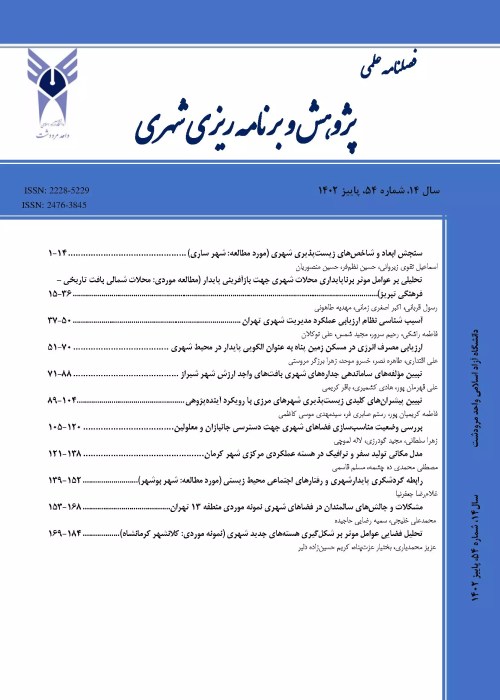Analysis of the status of safety indicators for regional and urban park(Conditions: Urmia City)
Urban parks are part of a public infrastructure that citizens can use for visual, environmental, educational, health, cultural, social and recreational entertainments. But one of the main challenges in realizing such vital functions of parks is lack of safety. Therefore, measuring the quality of park safety is important in order to improve its efficiency. The purpose of this study was to analyze the safety indexes of Urmia Regional and Urban Parks. The present research is applied in terms of its purpose and in terms of descriptive-analytic method. The method of data collection is documentary and survey. The sample size was estimated by the Cochran formula according to the scale and the population of 380 people at the areas where the parks were located. A random cluster sampling method was also used to select samples. Data processing tools include a multi-criteria decision-making model for checking the weight of the studied parks in terms of safety indicators and Pearson's path analysis and Pearson correlation coefficient for measuring the relationships between variables and the individual characteristics of the respondents.The results of the analysis indicate that: First, based on the model of the Gulflag Baghre Park with the number 5 is in the best conditions and the first rank and Saat Park with number 1 ranked 5th and is in the worst conditions. Second, according to the results of the analysis of path in relation to the most important safety indicators in the studied parks the physical safety index was recognized as a direct factor in the sense of safety with a beta of 394/0, a brightness index with a beta of 0.9 and an index of physical access with beta of 0.178 as the main indicators of safety sensitivity. Third, the Pearson correlation coefficient between two variables of immune indices and individual characteristics of respondents is equal to 613/0 and a significant level of less than 0.05 indicates a positive and significant correlation between these variables. Parks are part of the public infrastructure that citizens can use for visual, environmental, educational, health, cultural, social and recreational entertainment; But one of the major challenges in accomplishing such vital functions of parks is the lack of sufficient safety. If parks are perceived as unsafe, they may reduce visits and affect citizens' health, it also reduces citizens' sense of tranquility and participation in outdoor physical activity; In order to prevent and rebate the damages and dangers of using park services and facilities, including sharp cuts of objects and equipment, to secure these public environments that include floating social groups are indispensable and necessary. Hence, assessing the quality of parks safety is an important issue to improve its efficiency. In other words, the safety of parks is very important because of its great impact on different aspects of quality of life and sustainability of urban communities. First, this paper attempts to identify urban parks safety indicators and then analyze and prioritize the status and position of the regional and urban parks in these areas up to eventually provide to finding ways to improve the safety of these parks. Thus the main research questions are: 1) How is the quality and level of safety indicators of Urmiye Regional and Urban Parks? 2) What is the dispersion and spatial distribution of safety indexes in studied parks? 3) Is there a significant correlation between respondents' individual characteristics and safety indexes in study area?
This research is an applied based on purpose and descriptive – analytical type. The method of data collection is documentary and surveying; All survey methods such as questioner, interview and field observation were used to match the data and indicators used with the existing facts. The designed questionnaire was performed with a five-point Likert scale, focusing on five key indicators. The validity of questionnaire was content-based, so that quality of measuring tool was improved after experts' review and elimination of duplicate and ambiguous questions. Cronbach's alpha test was used to assessment the reliability of research tools. Hence, questionnaire was completed by 36 people (6 people in each park) in the pre-test phase and its Cronbach's alpha coefficient was 0.885 indicating that questionnaire was suitable for data collection. The statistical population of this study is visitors of Urmiye parks. The sample size was estimated to be 380 person using Cochran formula. The number of samples were estimated in Forest Park, Ellar Baghei, Gollar Baghei, coastal, Tokhm-Morghei and Saat Parks, respectively, about 158, 89, 54, 29, 30 and 19 persons. Cluster random sampling was used to select of samples (each park was considered as a cluster). Data analyses tools including: multi-criteria decision making such as Electere,for weighting of studied parks in terms of safety indices and Path Analysis test and Pearson correlation coefficient for measuring the relationships between variables and individual characteristics of respondents. SPSS and Arc GIS software were used to perform the calculations and display results of the analyzes.
To analyze of studied parks in terms of safety, a decision matrix was formed. The weight and importance of each criterion were calculated using Hierarchical Analysis (AHP). Among the indicators, physical accessibility (0.221) is more important. Lighting (0.220) is in second place, the calculated weights for physical safety index (0.126), safety feeling (0.122), and health safety (0.083) which are in next order. After performing Electere model steps, it was distinguished that level of safety was not same between studied parks and there was a significant difference between them in terms of safety indices; The Gollar Baghei Park has the highest level of safety with "5" dominance. After that, Tokhm-Morghei parks with dominance of "4" are in the second rank and Coastal and Ellar Baghei parks with dominance of "3" are in the third place. Forest Park with dominance "2" is in the fourth rank and finally Saat Park with dominance "1" is at the lowest level. Among the five variables studied, variables of safety sense and health safety had no direct effect and were determined physical safety variable with coefficient of 0.394, brightness 0.179 and physical access with 0.178 had the most direct effect. The indirect effects of variables are that physical safety has no indirect effect and physical accessibility variable with coefficient (0.182) has the highest indirect impact. Pearson test was used to measuring of significant relationship between respondents' individual characteristics and safety indices. The correlation coefficient value among two variables is equal to "0.061" and since the level of significance is equal to "0.000" and its value is less than "0.05", so there is positive correlation between two variables.
The results of study in terms of measuring to spatial distribution of safety indices in the studied parks showed that spatial distribution was heterogeneous among these parks, respectively, results of Electre model represent Gullar baghei Park with dominance of 5, placed in the best condition (1st rank) and Saat Park with dominance 1 (5th rank) in the worst condition. In this context, results of Ebrahimzadeh's and Rustaei (2016) research are almost similar to those of present study. According to the results of Path Analysis test in relation to the most important safety indices in studied parks, it can be said that physical safety index as a direct factor in safety sense with 0.394 beta, brightness index with 0.179 beta and accessibility physical index with a beta of 0.178 are the main indicators of feeling safe. The results of Raya et al. (2006) research are similar to results of the present study in physical safety index and physical accessibility. It is also different from the results of Khakpour et al. (2017) research.
- حق عضویت دریافتی صرف حمایت از نشریات عضو و نگهداری، تکمیل و توسعه مگیران میشود.
- پرداخت حق اشتراک و دانلود مقالات اجازه بازنشر آن در سایر رسانههای چاپی و دیجیتال را به کاربر نمیدهد.





